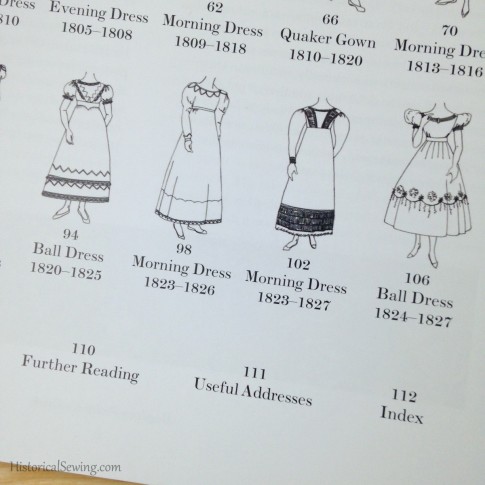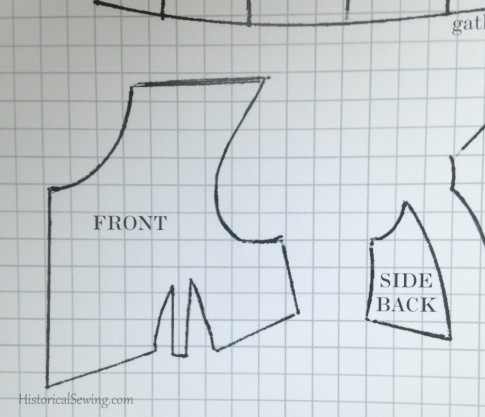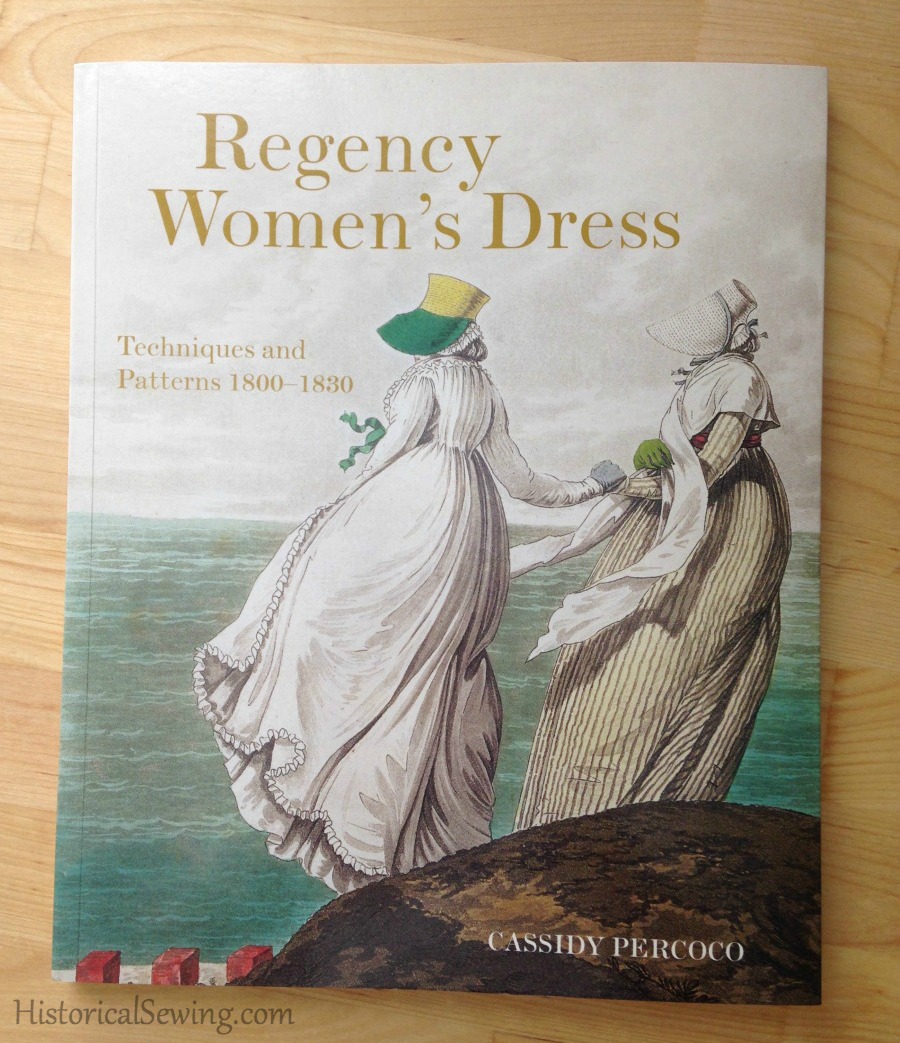This book, Regency Women’s Dress: Techniques and Patterns 1800-1830 by Cassidy Percoco, had been on my radar for a couple months after first stumbling upon it on Amazon last August. I waited for the release date of October 1st only to have it appear as “out of stock.” Sigh….
So when it was available again I jumped to order. I guess so did many of my costume friends as my Facebook feed was filled with status updates and photos showing a happy mail day that Tuesday. Ha!
When the book arrived I was pleasantly surprised and a bit disappointed.
Overall I think it’s a fine research book and a good addition for your costume library.
Ms. Percoco has studied, in-depth, the fashion of the early 19th century. A strong, but brief, “History of Regency Dress” at the beginning allows us to understand the general fashion with details on British versus French garments, the variety of garments from the era and their names, and specifics of the change in fashion from the late 18th century (the influential transition to Regency wear) through the 18-Teens (with only minor mention of the 1820s).

The focus of the book is on 26 original garments – mostly dresses and a couple chemises, stays and spencer jackets – in their fabric, construction, and pattern shapes. It’s the bulk of the book and the stuff we purchase it for.
It’s not unlike Janet Arnold’s wonderful “costumer bible” books: Patterns of Fashion series. There’s descriptions of fabrics, a bit of history, construction methods as well as the “why” behind them, measurements, and the all-important sketches of the garment pieces on graph paper which squares approximate one inch/10 centimeters.

The line drawings are decent. Understandable in the presentation although definitely hand drawn which might put off some people. I see them as a great resource to adapt modern patterns to fit the original garment piece shapes.
A total of four pages has been dedicated to each of the 26 garments: 1) title & dates, detailed description with fabrics and some measurements, and a detailed, color photo of a section of the garment; 2) a hand drawn sketch of the garment (either front or back view and the same as in the table of contents, and a fashion plate of the same time frame showing a similar garment (more on the first two pages below); 3 & 4) the garment pattern shapes drawn on the grid.

My biggest disappointment (and the same for other costumers I’ve heard from) is the color photograph, sketch and fashion plate for each garment.
It’s SO nice to see detailed photographs – in color – of antique garments! I love it. But where’s the full length shot? What does the garment really look like?
I put it on the same par as those fabulous pages we drool over in the Fashion in Detail book series. There’s one page of a detailed garment sketch with description and a second page of full-color photograph of only a detail or small portion of the garment. But for some reason, the Fashion in Detail books give you enough to understand what the full garment would look like.
Maybe it’s just me….
I would have liked to see a full-color, full-length photograph of each of the garments in Percoco’s book. It think it would make the book much higher in its research value. The detail photos are wonderful indeed. But combined with the *miniscule* sketch on the following page I feel like it’s missing the mark.
Instead, the included fashion plate takes center stage – not the garment. (And you know me and fashion plates – I [heart] them!)
Even if the hand sketch would have been the primary focus on that second page with the plate being secondary, my attention would stay focused on the garment and wanting to learn of its history and construction and story. The fashion plate would then be supportive research.
And on a few of them, the plate doesn’t really reflect the garment being discussed with it.
My guess (and it is just a guess) for the lack of a full garment photo is that the museums and collections Ms. Percoco was able to do hands-on research for her book would not allow photos of the entire garments. Perhaps the fee to use full-garment photos was too high for her book publication. Whatever, it is a bit disappointing not to see the garment in full length view.
As for the opposite focus of fashion plate versus sketch, perhaps the author loves fashion plates just like I do, or that the chosen plates are not those in wide circulation, or her confidence in her sketches is lacking so they were kept small and out of the way.
I do, however, appreciate all the work that went into compiling the garment information, sketches and plates and, of course, taking pattern shapes off all these wonderful existing garments. It is, indeed, a wealth of information!
It is a joy to own these types of pattern books because it allows us to see the shapes and seamlines that make a particular fashion era its own.
More than likely I won’t enlarge these patterns as they are drawn to re-create anything, but to merely utilize the vast information presented. I’ll use it to apply the shapes and construction to modern reproduction patterns. (I don’t reinvent the wheel!)
Do you have this new pattern book? Any opinions to share? Will you use it to create historical clothing garments?



I downloaded the Kindle version as soon as it was available and love to open and read the book while I am busy…waiting. Lovely little resource covering a quick transition period.
Thank you so, so much for reviewing my book! I gave the publisher a list of bloggers I thought should get a review copy, but unfortunately I’m not sure if any ARCs actually went out, so I’m dependent on (and grateful for!) readers reviewing out of the goodness of their hearts.
I really wish I could have done full-length photos of the garments. The trouble was that my time was really limited at each historic site (I could only take a day off here and there to visit them, and they took a decent amount of driving to get to), and very few of them were set up to dress mannequins or forms, let alone photograph them against neutral backgrounds. They’re also not set up with rigs to take decent lying-down photos, which I find very frequently look messy anyway. Drawings seemed like the best way to depict the dresses, and I had them done by a local illustrator, going off my detail photos and descriptions.
For the related illustrations (the mostly fashion plates), I had to choose from a specific image bank for financial reasons. There were hardly any attributions, so I had to figure out what publication they were from and when they were published. I had to settle for “basically related” in some cases, which wasn’t ideal. My hope is that my openness and willingness to chat with anybody who has a question about the book and emails me or comments on my blog will make up for its shortcomings!
Using the patterns to adjust commercial ones is totally something I intended them for! I can’t wait to see your next Regency project.
Hi Cassidy! Thank you so much for the clarification. So nice to hear the story behind the process. 🙂